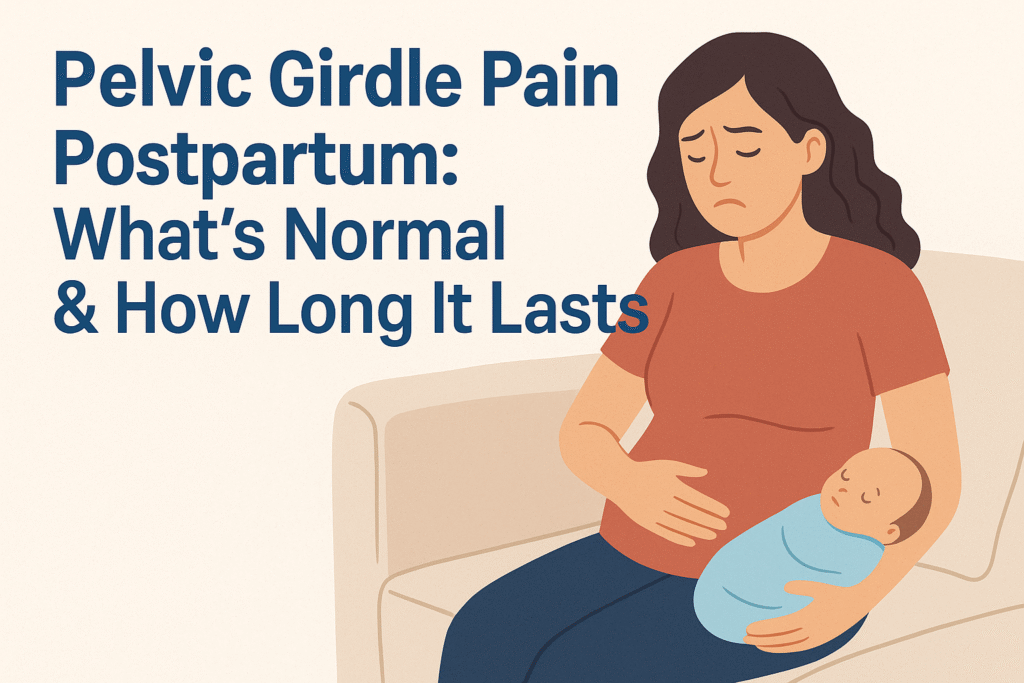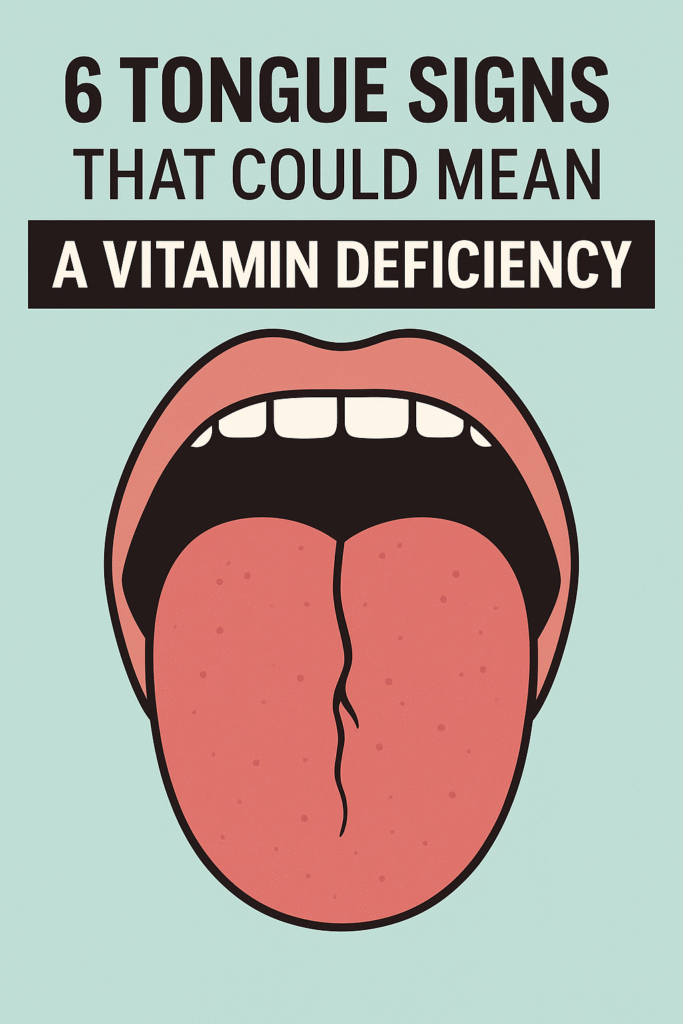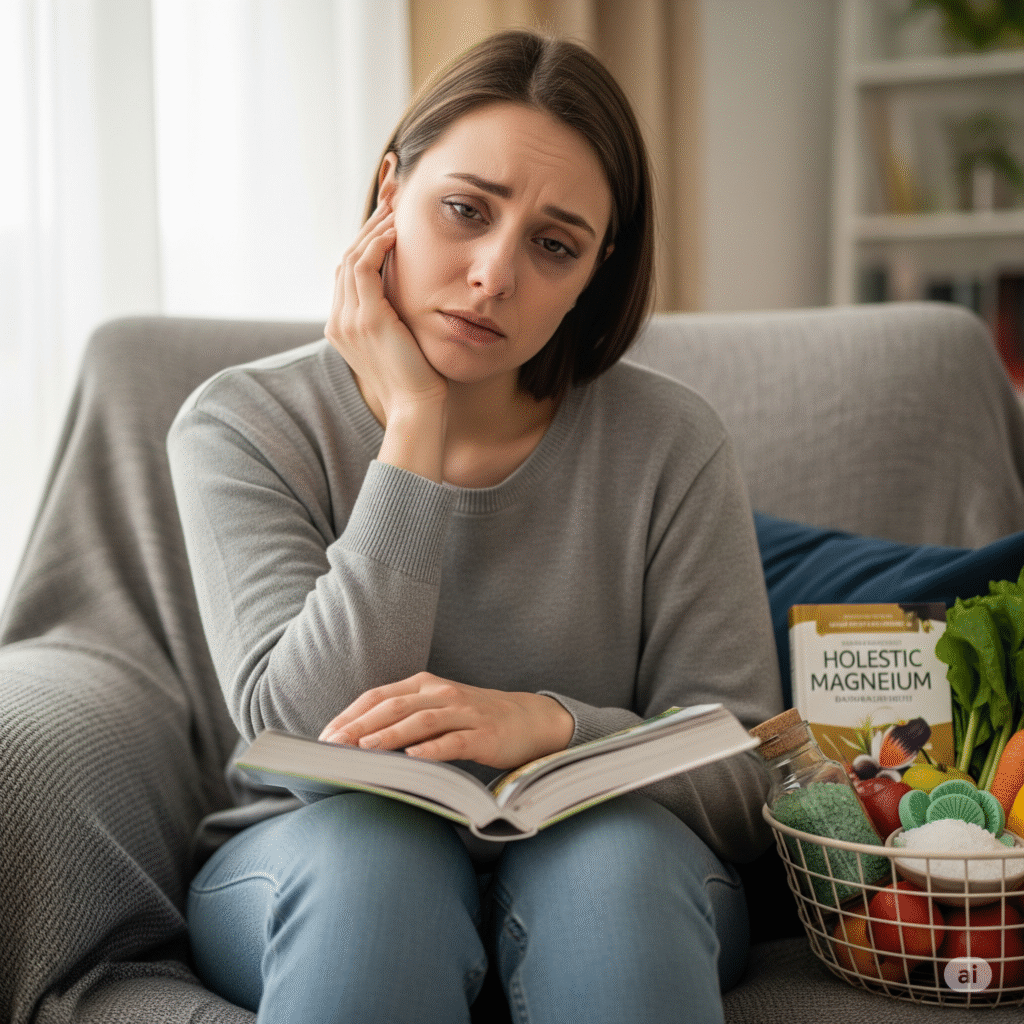
⚠️ Affiliate Disclaimer: This post may contain affiliate links, which means I may earn a small commission — at no extra cost to you — if you make a purchase through one of these links. I only recommend products or services I genuinely trust and believe can provide value. Thank you for supporting My Medical Muse!
Pelvic Girdle Pain Postpartum: 9 Essential Facts About What’s Normal & Recovery
Pelvic Girdle Pain Postpartum: What’s Normal and How Long Does It Last?
Bringing a new life into the world is one of the most beautiful and transformative experiences a woman can go through, but while the arrival of a baby is often celebrated, the physical demands of pregnancy, labor, and delivery are immense, and recovery is not always straightforward. Many new mothers expect fatigue, emotional ups and downs, or breastfeeding challenges in the postpartum period. What often comes as a surprise, however, is the persistence of musculoskeletal pain especially pelvic girdle pain (PGP), long after childbirth.
If you’ve noticed lingering aches in your pelvis, hips, lower back, or thighs weeks or even months after giving birth, you are far from alone. Studies estimate that as many as 45% of women experience pelvic girdle pain during pregnancy, and for a significant number, those symptoms don’t disappear immediately after delivery. For some women, pelvic girdle pain becomes a daily hurdle that interferes with mobility, self-care, and even bonding moments with their newborn.
The good news is that pelvic girdle pain postpartum is usually temporary and manageable, especially with the right understanding and support. Recovery takes time, but by learning what’s normal, what requires attention, and how to actively promote healing, you can take back control of your body and well-being.
In this comprehensive guide, we’ll cover:
- What pelvic girdle pain actually is and how it affects the body.
- Why it often continues after childbirth instead of disappearing right away.
- The symptoms that are considered normal versus those that should raise concern.
- How long pelvic girdle pain typically lasts, including recovery timelines most women can expect.
- Risk factors for prolonged or severe pain that may delay recovery.
- Effective treatment options and lifestyle adjustments you can start using immediately to ease discomfort.
- When to seek professional medical help to ensure nothing more serious is at play.
By the end of this article, you’ll have a clear, evidence-based understanding of what’s happening in your body, along with practical steps to support your recovery. Whether you are a few weeks or many months postpartum, know that you’re not alone and that healing is absolutely possible.
What Is Pelvic Girdle Pain?
The pelvic girdle is a strong yet flexible ring of bones located at the base of the spine. It consists of the sacrum, coccyx, and the paired hip bones (ilium, ischium, and pubis). Together, these structures form the foundation that supports your spine, hips, and legs, while also protecting internal organs such as the bladder and reproductive system.
During pregnancy, the body produces hormones most notably relaxin and progesterone, to loosen ligaments and soften joints in preparation for childbirth. While this natural process makes the pelvis more flexible for delivery, it can also reduce joint stability, sometimes causing inflammation, strain, and pain.
Pelvic girdle pain refers to discomfort that originates in this region. It can radiate to the hips, lower back, buttocks, or thighs, and may feel:
- Sharp or stabbing during sudden movements.
- Achy or heavy after standing or walking for long periods.
- Clicking, grinding, or popping with certain motions, like rolling over in bed.
pelvic girdle pain is often aggravated by everyday activities like walking, climbing stairs, or even shifting positions and for some women, it can be severe enough to limit mobility.
Causes of Pelvic Girdle Pain After Birth
Some women feel instant relief after delivery, while others notice that pain lingers or even worsens. Several factors explain why pelvic girdle pain can persist postpartum:
1. Hormonal Aftermath
The hormonal effects of pregnancy don’t vanish immediately after birth.
- Relaxin and progesterone remain elevated for weeks or months, leaving ligaments looser than normal.
- This lingering ligament laxity means the pelvis may remain slightly unstable, especially if combined with muscle weakness.
2. Muscle Weakness
Pregnancy and delivery stretch the abdominal wall, pelvic floor, and core stabilizing muscles.
- When these muscles are weakened, the joints of the pelvis, particularly the sacroiliac joints and pubic symphysis take on more stress.
- The imbalance can cause discomfort and prolong recovery.
3. Birth Trauma
The mechanics of labor itself may contribute to postpartum PGP.
- Vaginal deliveries involving forceps, vacuum extraction, or prolonged pushing can put extra strain on pelvic joints.
- In some cases, women may develop pubic symphysis separation or sacroiliac joint dysfunction, which takes longer to heal.
4. Postpartum Lifestyle Factors
Caring for a newborn often means repetitive, physically demanding tasks.
- Lifting, bending, and twisting to carry the baby, car seat, or stroller puts pressure on the pelvis.
- Long hours spent in awkward postures during breastfeeding, rocking, or co-sleeping can further strain already vulnerable joints.
What Does Normal Pelvic Girdle Pain Feel Like Postpartum?
Every woman’s recovery experience is unique, but some symptoms are widely reported as typical:
- Localized pain in the pubic bone, groin, hips, or lower back.
- Discomfort with movement, especially when walking, climbing stairs, standing on one leg (e.g., getting dressed), or turning in bed.
- Clicking or popping sensations in the pelvic joints.
- Increased pain after physical activity, prolonged standing, or long sitting sessions.
- Relief with rest, especially when lying flat on the back with knees supported.
In most cases, mild to moderate pain that gradually improves within weeks is considered normal. However, pain that is severe, worsening, or interfering with daily life should be taken seriously and evaluated by a healthcare professional.
How Long Does Pelvic Girdle Pain Last Postpartum?
Recovery timelines for pelvic girdle pain vary from woman to woman. Several factors such as the severity of pain during pregnancy, type of delivery, physical fitness, and support with postpartum care play a role.
- Short-term recovery (6-12 weeks): Many women notice steady improvement as hormones stabilize and muscles slowly regain strength.
- Intermediate recovery (3-6 months): With consistent physiotherapy and gentle exercise, the majority experience significant reduction in symptoms.
- Persistent pain (6-12 months): Around 7-10% of women report ongoing pelvic girdle pain up to a year after delivery.
The reassuring news is that with proper support, the outlook is excellent. Most women recover fully, regaining stability and strength in the pelvis with time, exercise, and, when needed, physiotherapy.
Risk Factors for Prolonged Pelvic Girdle Pain
While many women recover from pelvic girdle pain within a few weeks or months postpartum, some find that symptoms linger longer than expected. Understanding the risk factors can help identify why recovery may take more time and guide appropriate treatment.
The following factors increase the likelihood of prolonged or more severe postpartum pelvic pain:
- Severe pelvic girdle pain during pregnancy:
Women who struggled with significant pelvic pain while pregnant are more likely to continue experiencing discomfort after delivery. - Multiple pregnancies (twins or more):
Carrying multiples places extra strain on the pelvic joints and connective tissue, making recovery slower. - High birth weight baby:
Larger babies can increase pressure on the pelvis during pregnancy and delivery, contributing to joint stress and soft tissue injury. - Instrumental delivery (forceps or vacuum):
These interventions, while sometimes necessary, can cause additional strain or trauma to the pelvic region. - History of low back pain or pelvic trauma:
Pre-existing musculoskeletal issues may resurface or worsen during the postpartum period. - Weak core or pelvic floor muscles
Poor muscle support leaves the pelvis less stable, making pain more likely to persist. - Inadequate postpartum rehabilitation
Without guided recovery exercises, the body may struggle to regain strength and stability, prolonging symptoms.
The presence of these factors does not mean you will have long-lasting pain but it does mean you should be proactive about recovery and seek support early if symptoms persist.
Treatment and Management Strategies
Pelvic girdle pain can be discouraging, but the encouraging news is that there are highly effective management strategies to reduce discomfort and promote healing. A combination of professional support, gentle movement, and lifestyle adjustments usually provides the best results.
1. Physiotherapy
One of the most effective treatments for PGP is working with a women’s health physiotherapist.
- They provide individualized exercise plans tailored to strengthen weak muscles and restore balance.
- Focus areas often include:
- Pelvic floor strengthening to improve stability.
- Core activation to support the lower back and pelvis.
- Glute strengthening to aid hip and pelvic alignment.
- Pelvic floor strengthening to improve stability.
- In some cases, manual therapy can help realign the sacroiliac joints or release muscle tension.
2. Exercise and Movement
Movement is medicine, but the type and intensity matter.
- Gentle, low-impact exercises like walking, swimming, or postnatal yoga are excellent for gradually rebuilding strength without overloading the pelvis.
- Avoid high-impact activities such as running, jumping, or heavy weightlifting until cleared by your healthcare provider.
- Consistency is more important than intensity. Small, regular sessions are more effective than occasional strenuous workouts.
3. Supportive Devices
Sometimes, simple external support can make a big difference.
- Pelvic support belts or binders can reduce instability and provide relief, especially in the early postpartum weeks.
- Ergonomic cushions or chairs help with prolonged sitting during breastfeeding, preventing pelvic misalignment.
- Using a firm mattress or supportive pillow between the knees while sleeping can also improve alignment.
4. Lifestyle Adjustments
Daily habits play a huge role in either aggravating or easing pelvic pain.
- Avoid heavy lifting or carrying your baby on one hip for long periods.
- Use both hands and balanced postures when holding or lifting your child.
- Maintain good posture when sitting or standing, small changes reduce cumulative strain.
- Practice safe movement strategies, such as rolling onto your side before getting out of bed, rather than sitting straight up.
5. Pain Relief
Managing pain allows you to stay active, which in turn supports recovery.
- Over-the-counter medications like ibuprofen or paracetamol may be helpful but should always be used under medical guidance, especially if you are breastfeeding.
- Non-drug approaches such as warm compresses, gentle stretching, or massage can also ease discomfort.
- Some women find relief through alternative therapies like acupuncture or chiropractic care, though these should be discussed with your doctor first.
Preventing Future Pelvic Girdle Pain in Subsequent Pregnancies
If you’ve experienced pelvic girdle pain during or after pregnancy, it’s natural to worry about whether it will happen again. While having a history of pelvic girdle pain does increase the likelihood of recurrence, there are proactive steps you can take to reduce the risk and severity in future pregnancies.
1. Strengthen Before Conception
- Focus on core stability and pelvic floor strength through guided physiotherapy or low-impact exercise.
- Include strengthening of the glutes, hips, and lower back, which all play a role in stabilizing the pelvis.
2. Maintain a Healthy Weight
Excess weight adds strain to the pelvic joints. Working toward a healthy pre-pregnancy weight can help minimize stress on the pelvis during subsequent pregnancies.
3. Stay Active During Pregnancy
- Gentle activities like walking, swimming, and prenatal yoga can help keep muscles strong and joints supported.
- Avoid high-impact exercises or movements that cause pain.
4. Use Supportive Gear
- A maternity support belt or belly band during pregnancy can reduce pelvic strain.
- Proper footwear with arch support also improves alignment and decreases stress on the pelvis.
5. Monitor Posture and Movement
- Be mindful of daily habits like standing on one leg while dressing, carrying a toddler on one hip, or slouching while sitting.
- Small posture adjustments can make a big difference in pelvic alignment over time.
6. Seek Early Professional Support
If pain reappears in a future pregnancy, don’t wait until it becomes severe. Consult a women’s health physiotherapist early to prevent symptoms from worsening.
Experiencing PGP once doesn’t mean you’re destined to struggle every pregnancy With strength training, proactive self-care, and early intervention, many women find subsequent pregnancies more comfortable and manageable.
When to See a Doctor
Most cases of postpartum pelvic girdle pain improve naturally with time, rest, and gentle rehabilitation. However, it’s important to recognize when medical evaluation is necessary. Seek professional help if you experience:
- Severe or worsening pelvic pain that does not improve with rest or gentle self-care.
- Pain that significantly limits mobility or daily activities, such as walking, lifting your baby, or performing household tasks.
- Numbness, tingling, or shooting pain down the legs, which may indicate nerve involvement (such as sciatica).
- Pelvic pain accompanied by fever, chills, or urinary/bowel changes, which could suggest infection or another complication.
- Symptoms persisting beyond six months despite physiotherapy, exercise, or lifestyle modifications.
A doctor may recommend further investigations such as X-ray, MRI, or ultrasound to assess the joints and soft tissues. Depending on the findings, you may be referred to a physiotherapist, osteopath, orthopedist, or pain specialist for targeted care.
Emotional and Mental Health Impact
Pelvic girdle pain is more than just a physical problem, it can have a profound impact on mental and emotional well-being. For new mothers, these struggles may include:
- Frustration and discouragement from physical limitations that make everyday tasks feel overwhelming.
- Isolation and loneliness due to reduced mobility or difficulty participating in social and family activities.
- Anxiety and stress when pain interferes with caring for a newborn or bonding moments.
- Feelings of guilt or inadequacy for not being able to “bounce back” as quickly as expected.
It’s important to remember that these emotions are completely valid. Seeking emotional support, whether through talking with a partner, joining a postpartum support group, or working with a mental health professional can be just as crucial as physical treatment. A holistic recovery addresses both body and mind.
Recovery Timeline and Outlook
While every woman’s journey is unique, the general recovery timeline for pelvic girdle pain postpartum looks like this:
- 0-6 weeks postpartum: Discomfort is common as the body heals and hormones begin to stabilize. Pain should gradually ease with rest, gentle stretching, and supportive positioning.
- 6-12 weeks postpartum: Most women notice steady improvement, especially if incorporating light exercise, physiotherapy, or lifestyle adjustments.
- 3-6 months postpartum: Significant reduction in symptoms is expected for the majority, with many regaining confidence in movement and strength.
- 6-12 months postpartum: A small percentage (around 7-10%) may continue to experience persistent pain that requires specialized medical care and long-term rehabilitation.
The outlook for recovery is excellent, with proper treatment and self-care, most women regain full pelvic function, strength, and mobility allowing them to return to normal activities and enjoy motherhood without constant discomfort.
Pelvic girdle pain postpartum is common but temporary for most women. If symptoms persist or worsen, professional help is available, and with the right support, recovery is always possible.
Practical Tips for Daily Life
Managing pelvic girdle pain postpartum isn’t just about formal treatment, it’s also about the small, everyday adjustments that reduce strain and support healing. By building good habits into your routine, you can protect your pelvis, ease discomfort, and move more confidently.
Here are some simple but powerful tips:
- Feeding time: Use pillows or a breastfeeding support cushion to bring your baby up to you, rather than hunching forward. This reduces strain on your pelvis and lower back.
- Babywearing: Choose ergonomic baby carriers that distribute weight evenly across your shoulders, back, and hips. Avoid slings or carriers that put uneven pressure on one side of the body.
- Household chores: Break tasks into smaller, more manageable steps. For example, fold laundry in short bursts rather than standing for long periods. This prevents fatigue and overloading your pelvic joints.
- Footwear: Wear supportive, cushioned shoes to absorb impact and improve stability. Avoid high heels, flat unsupportive sandals, or worn-out sneakers, as these can worsen alignment issues.
- Rest smart: When lying down, place a pillow between your knees (or under your belly if side-lying) to keep the pelvis in a neutral position. When getting out of bed, roll to your side first rather than sitting straight up.
- Lift with care: When lifting your baby or other objects, bend your knees and keep the load close to your body instead of bending from the waist.
These small adjustments may seem minor, but practiced consistently, they make a big difference in reducing pain and promoting long-term recovery.
Conclusion
Pelvic girdle pain postpartum is both common and normal a reflection of the incredible physical changes your body has undergone to bring life into the world. While it can be discouraging and frustrating in the early weeks, the good news is that for most women, symptoms gradually improve within a few months, with proactive care through physiotherapy, exercise, and lifestyle adjustments, you can significantly shorten your recovery time and regain confidence in your body.
If your pain is severe or persistent, remember that you do not have to endure it in silence. Seeking professional guidance is not a sign of weakness but a step toward healing. Early support from healthcare providers, physiotherapists, and even emotional support networks can transform your recovery experience, with patience, consistency, and the right interventions, you can look forward to a strong, pain-free, and active life, one where you’re able to fully enjoy motherhood without being held back by pelvic pain.
👩⚕️ Need Personalized Health Advice?
Get expert guidance tailored to your unique health concerns through MuseCare Consult. Our licensed doctors are here to help you understand your symptoms, medications, and lab results—confidentially and affordably.
👉 Book a MuseCare Consult NowRelated Blog Post You Might Like:
- 7 Powerful Signs Severe Cramps in Teens Could Be Endometriosis
- 10 Powerful Facts About Hormonal Contraceptives You Must Know
- Irregular Cycles After Stopping Birth Control: 7 Powerful Facts You Must Know
- Mid-Cycle Spotting Explained: 10 Key Facts About Ovulation Bleeding
- How Long Before Estrogen Cream Works: 3 Proven Timelines for Vaginal Dryness Relief


